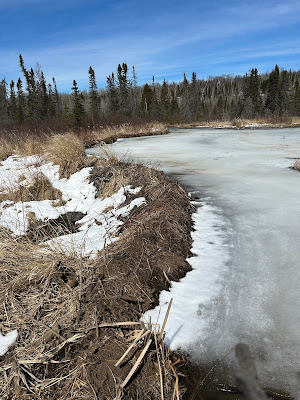Cedar Creek Beaver Ponds
It's been nearly a month since my last post. I'll try and catch up with logging some of my adventures over the next couple days, I'll probably end up combining many of them into a few posts because much of what I have been noticing is very similar from day to day.
On April 6th I made my way to the beaver dams on cedar creek (I think that the ponds might actual be on the beaver or palisade creek) just north of Bean and Bear Lakes. I had been to the north facing cliff and talus slope there early in the fall and seen some amazing lichens and plants. This trip I focused on the beaver ponds and surrounding area. This whole area has got to be one of the best biodiversity hotspots on the North Shore: the surrounding forest is dominated by red oaks and maples; on top of the cliff it is white spruces, firs, and white pines; there is a nearby section of logged forest with aspens popping up; add in the magic of a huge north facing cliff; and along the river there were signs of very recent activity and also areas that have been beaver free for a while. I plan on coming back many times at varying seasons to try and capture more of the diversity in all these unique habitats.
As I was walking along the road I stopped off along cedar creek for a while. While exploring, I marveled at some really old white cedars. Shortly after I stumbled upon a decent patch of white rattlesnake root (Nabalus albus, say that 10 times fast!). I've been searching for the gall wasp Aulacidea nabili which is found right at the crown of the plant. I didn't find any galls, but did find some agromyzid fly pupa (which belong to the genus Melanagromyza) in the stems.













Comments
Post a Comment